|
|
|
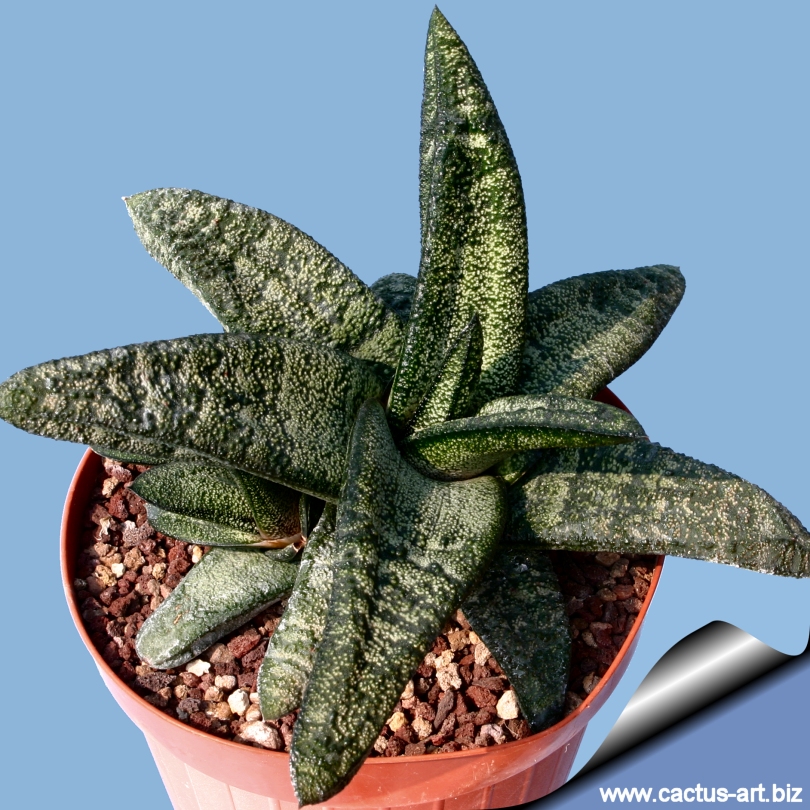
Gasteria batesiana is a small charming species bearing wonderful dark
rough textured leaves that looks-like a reptilian skin. They will make
nice rosettes that take on a reddish colour in strong light.
|
|
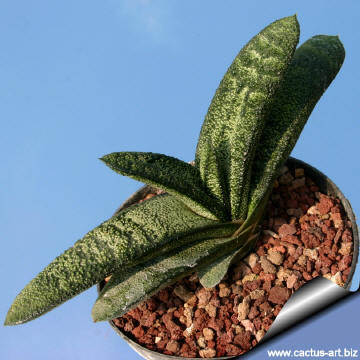
Young leaves are initially in two opposite rows. |
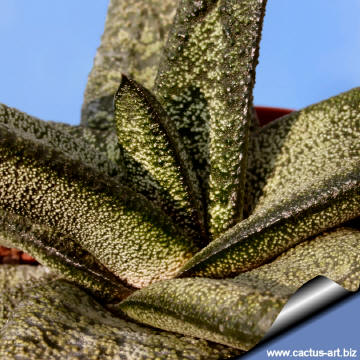
Leaves are dark-green with raised pearly dots. |
|
. |
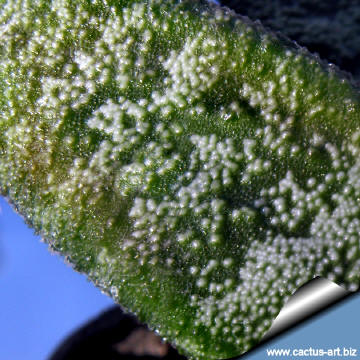 |
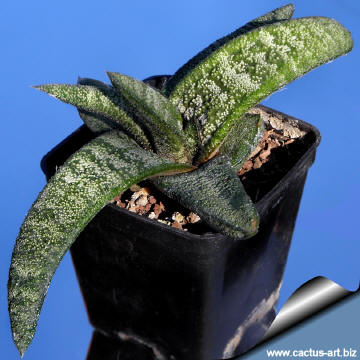 |
|
. |
|
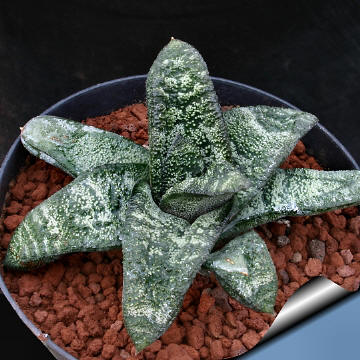
It is ideal for containers in a shady
spot.
|
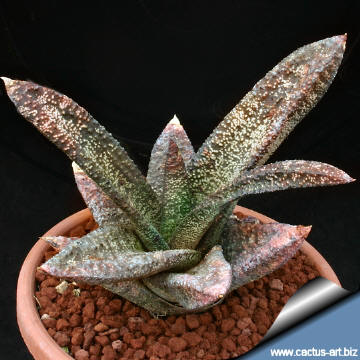
but it takes a nice red tinge in strong light
|
|
Cultivation: They are slow growing but
long-lived plants of easy culture which
makes them a good houseplant and can be an excellent subject for the
beginning gasteriaphile (it can grow easily on window sills, verandas
and in miniature succulent gardens where they are happy to share their
habitat with other smaller succulent plants, or in outdoor rockeries)
Need light shade to shade, but will take full sun part of the day. (with
some sun exposure the leaf develops a nice reddish tint and remain
compact) They are tolerant of a wide range of soils and habitats, but
prefer a very porous potting mix to increase drainage. During the hot
summer months, the soil should be kept moist but not overly wet. The
plants are fertilized only once during the growing season with a
balanced fertilizer diluted to ˝ the recommended strength. During the
winter months, water only when the soil becomes completely dry.
Frost hardy to -1°C (Or less). |
|
Advertising
|
|
|
|
|
Family: Asphodelaceae
Scientific name: Gasteria batesiana
Rowley
Origin: South Africa, this species has the most northerly
distribution in the genus, occurring from north of the Tukhela (Tugela)
River in northern KwaZulu-Natal to the Olifants River Valley in the
Limpopo Province.
Habitat and ecology:
It is a cliff dweller, found in savannah at elevations
from 500 to 700 m, in hot, dry, frost free river valleys in mountainous
terrain. Its habitat consists of shady southern and eastern aspects
where it occurs in shallow humus-rich soil (pH 6,8 – 7,1). Gasteria
batesiana is pollinated by sunbirds. Its fruiting capsules becoming
erect after fertilization, opening from the top only to release its
flattish seed by gusts of wind, thus ensuring a sufficient dispersal
distance. Its fleshy leaves store water making it a drought tolerant and
ideal water wise garden plant. In spite of its habitat on cliffs
becoming bone dry during winter, the plants have enough water supply for
survival.
Etymology: The genus name "Gasteria" comes from
"gaster" the greek word for stomach.
The species name "batesiana" commemorates Mr. John Bates,
a trolley bus conductor in London and a keen collector of South African
succulents.
Synonyms:
- Gasteria transvaalensis Rowley
- Gasteria carinata Rowley
- Gasteria subverrucosa var. marginata
Common Names include: (English)
Cow Tongue,
(Afrikaner) knoppies-beestong.
|
|
|
|
Description: Small rosette succulent that proliferates from the base
forming small groups, rarely solitary. It usually larger than tall and
grows 30 to 100 mm tall and 80-300 mm in diameter. The plants in the
wild are very variable especially for shape and roughness of the leaves
.
Stem: Nearly stem less (acaulescent).
Roots: Succulent and cylindrical (terete). The roots are thick
with little branching, and endowed with the ability to
contract, physically pulling the plant down into the ground during
dry weather.
Leaves: 50-180 cm long, 15-40 mm wide, very firm with
translucent, smooth epidermis, triangular-lanceolate, strap-shaped or
rarely linear, ascending spreading ultimately becoming recurved. The
upper surface becoming channeled during the drought. The lower surface
is convex bearing an excentric keel. Young leaves are initially in two
opposite rows (distichous
) then spiral with age becoming rosulate. Both surfaces are dark almost
black-green or glaucous taking on a reddish colour in strong light, they
are mottled with dense white spots arranged in transverse bands and
distinctly densely tuberculate, with larger and smaller green or white
pearly, raised, tubercles. The leaf apex is obtuse bearing a mucro.
Inflorescence: Simple or branched ascending, spreading, arching,
raceme 300-450 mm tall from which small stomach-shaped flowers dangle.
The tubular flowers are 28-40 mm long with the lower part infated (“gaster”
from Greek, means “belly”) the base slightly swollen, translucent
pink-orange flowers tipped in emerald green . The stamens are shortly
exserted or protruding. The ovary 7 X 3 mm cylindrical bearing a style
of 15 mm in length. The stigma included or becoming shortly exserted.
The pedicel is drooping and 9 mm long. The flowers produce abundant
nectar and attract sunbirds during spring.
Fruit: The capsule 16-20 mm long bearing black flattened seed
4-6˙ mm long, 2-3 mm large..
Flowering time (Europe): Spring
NOTE: Gasteria batesiana is related to G tukhelensis,
another cliff dweller.
|
|
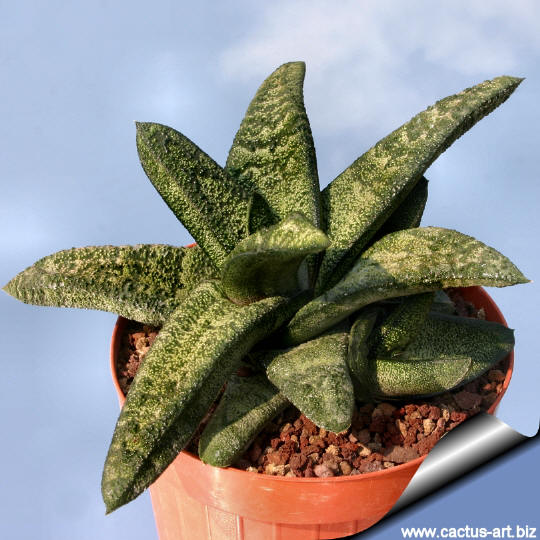
Traditional uses: These
plants are popular among the traditional healers that believe they have
the magical power of transferring their camouflage properties, which are
provided by their mottled leaves that blend in well with surrounding
vegetation, to humans who wash with the leaves.
Propagation: Gasteria is easily propagated by the removal of
offshoots or by leaf cuttings in spring or summer. To
use offshoots
It should stay intact in the post though every head will have its own
root system and it could easily be split for propagation.
To propagate by leaf
cuttings, remove a leaf and let it lie for about one month
(e.g. in a cool window sill), giving the
wound time to heal. Then lay the leaf on its side with the basal part
buried in the soil. This leaf should root within a month or two, and
small plants will form at the leaf base. Young plants
can be harvested the following season. They can also grown from seed.
Seed should be sown during summer in sandy well
drained soil and preferably protected from full sun. The seedlings are
slow growing and can be planted out in small containers when they are
large enough to handle. The soil should preferably be enriched with
compost. They react very well to a liquid organic fertilizer.


|
|